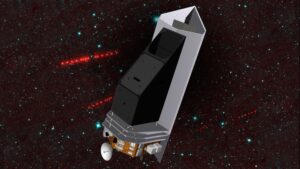Asteroid coming exceedingly close to Earth, but will miss
Thursday, 26 January 2023 12:00
The Sample Transfer Arm – A helping hand for Mars
Thursday, 26 January 2023 12:00 Video:
00:01:07
Video:
00:01:07
The mission to return martian samples back to Earth will see a European 2.5 metre-long robotic arm pick up tubes filled with precious soil from Mars and transfer them to a rocket for an historic interplanetary delivery.
The sophisticated robot, known as the Sample Transfer Arm or STA, will play a crucial role in the success of the Mars Sample Return campaign.
The Sample Transfer Arm is conceived to be autonomous, highly reliable and robust. The robot can perform a large range of movements with seven degrees of freedom, assisted by two cameras and a myriad of
NASA adds asteroid flyby to Lucy mission
Thursday, 26 January 2023 11:52
NASA has added another asteroid flyby to its Lucy mission later this year that will provide a test of its capabilities for future encounters.
The post NASA adds asteroid flyby to Lucy mission appeared first on SpaceNews.
NEO Surveyor launch delayed despite funding boost
Thursday, 26 January 2023 10:59
While Congress provided more funding than NASA requested for an asteroid mission, agency officials said it will not prevent a two-year slip in its launch.
The post NEO Surveyor launch delayed despite funding boost appeared first on SpaceNews.
Tiny asteroid to pass close by Earth today
Thursday, 26 January 2023 05:41 On Thursday, Jan. 26, a small near-Earth asteroid will have a very close encounter with our planet. Designated 2023 BU, the asteroid will zoom over the southern tip of South America at about 4:27 p.m. PST (7:27 p.m. EST) only 2,200 miles (3,600 kilometers) above the planet's surface and well within the orbit of geosynchronous satellites.
There is no risk of the asteroid impacting Earth. Bu
On Thursday, Jan. 26, a small near-Earth asteroid will have a very close encounter with our planet. Designated 2023 BU, the asteroid will zoom over the southern tip of South America at about 4:27 p.m. PST (7:27 p.m. EST) only 2,200 miles (3,600 kilometers) above the planet's surface and well within the orbit of geosynchronous satellites.
There is no risk of the asteroid impacting Earth. Bu Stratolaunch creates Advanced Program Office at Purdue for hypersonics
Thursday, 26 January 2023 05:41 Stratolaunch LLC and Purdue University are pleased to announce they have established a partnership dedicated to accelerating the time required to design, build, test and fly hypersonic vehicles.
Stratolaunch will establish the Stratolaunch Advanced Programs Office at the Convergence Center in Purdue's Discovery Park District in West Lafayette, Indiana, to ensure the goals of their collabor
Stratolaunch LLC and Purdue University are pleased to announce they have established a partnership dedicated to accelerating the time required to design, build, test and fly hypersonic vehicles.
Stratolaunch will establish the Stratolaunch Advanced Programs Office at the Convergence Center in Purdue's Discovery Park District in West Lafayette, Indiana, to ensure the goals of their collabor DARPA, NASA Collaborate on Nuclear Thermal Rocket Engine
Thursday, 26 January 2023 05:41 DARPA, via its Demonstration Rocket for Agile Cislunar Operations (DRACO) program, is collaborating with NASA to build a nuclear thermal rocket (NTR) engine that could expand possibilities for the space agency's future long-duration spaceflight missions. The goal is to test an NTR-enabled spacecraft in Earth orbit during the 2027 fiscal year. An NTR presents advantages over existing propulsion t
DARPA, via its Demonstration Rocket for Agile Cislunar Operations (DRACO) program, is collaborating with NASA to build a nuclear thermal rocket (NTR) engine that could expand possibilities for the space agency's future long-duration spaceflight missions. The goal is to test an NTR-enabled spacecraft in Earth orbit during the 2027 fiscal year. An NTR presents advantages over existing propulsion t OneWeb and Marsh's mission-critical collaboration continues
Thursday, 26 January 2023 05:41 OneWeb, the low Earth orbit (LEO) satellite communications company, and Marsh, the world's leading insurance broker and risk advisor, have announced that their relationship will continue through in 2023, covering launches from the US and India.
OneWeb signed an agreement for an aggregate insured value of more than $1 billion through Marsh in September 2021 and now that relationship will co
OneWeb, the low Earth orbit (LEO) satellite communications company, and Marsh, the world's leading insurance broker and risk advisor, have announced that their relationship will continue through in 2023, covering launches from the US and India.
OneWeb signed an agreement for an aggregate insured value of more than $1 billion through Marsh in September 2021 and now that relationship will co Viasat managed services contract by US Marine Corps
Thursday, 26 January 2023 05:41 Viasat Inc. (NASDAQ: VSAT), a global communications company, has announced it was awarded a contract to provide end-to-end satellite communications (SATCOM) support through a fully managed service to the United States Marine Corps (USMC). The contract is an extension following a successful pilot and follow-on service program in the government's FY22 through which Viasat delivered a fully managed
Viasat Inc. (NASDAQ: VSAT), a global communications company, has announced it was awarded a contract to provide end-to-end satellite communications (SATCOM) support through a fully managed service to the United States Marine Corps (USMC). The contract is an extension following a successful pilot and follow-on service program in the government's FY22 through which Viasat delivered a fully managed Hawkeye 360 launches Cluster 6 satellites aboard inaugural Rocket Lab Electron flight from Virginia
Thursday, 26 January 2023 05:41 HawkEye 360 Inc., the world's leading commercial provider of space-based radio frequency (RF) data and analytics, announced that its Cluster 6 next-generation satellites have successfully deployed to orbit aboard the inaugural Rocket Lab Electron flight from Launch Complex 2 at Virginia Space's Mid-Atlantic Regional Spaceport within NASA's Wallops Flight Facility. Communication with the satellit
HawkEye 360 Inc., the world's leading commercial provider of space-based radio frequency (RF) data and analytics, announced that its Cluster 6 next-generation satellites have successfully deployed to orbit aboard the inaugural Rocket Lab Electron flight from Launch Complex 2 at Virginia Space's Mid-Atlantic Regional Spaceport within NASA's Wallops Flight Facility. Communication with the satellit Nanoparticles make it easier to turn light into solvated electrons
Thursday, 26 January 2023 05:41 There are many ways to initiate chemical reactions in liquids, but placing free electrons directly into water, ammonia and other liquid solutions is especially attractive for green chemistry because solvated electrons are inherently clean, leaving behind no side products after they react.
In theory, solvated electrons could be used to safely and sustainably break down carbon dioxide or che
There are many ways to initiate chemical reactions in liquids, but placing free electrons directly into water, ammonia and other liquid solutions is especially attractive for green chemistry because solvated electrons are inherently clean, leaving behind no side products after they react.
In theory, solvated electrons could be used to safely and sustainably break down carbon dioxide or che UK Space Agency announces new funding for satellite communications
Thursday, 26 January 2023 05:41 The UK Space Agency has announced 50 million pounds of funding for ambitious and innovative projects that will supercharge the UK's satellite communications industry. The funding is part of the European Space Agency (ESA) Advanced Research in Telecommunications Services (ARTES) program and will be used to develop new satellite constellations, ground systems, and end-to-end systems that deliver n
The UK Space Agency has announced 50 million pounds of funding for ambitious and innovative projects that will supercharge the UK's satellite communications industry. The funding is part of the European Space Agency (ESA) Advanced Research in Telecommunications Services (ARTES) program and will be used to develop new satellite constellations, ground systems, and end-to-end systems that deliver n GMV to develop the ground control center for Hisdesat's new
Thursday, 26 January 2023 05:41 The Spanish government satellite operator, Hisdesat, has awarded multinational GMV a contract to build and develop the ground segment of the SPAINSAT NG program satellites. The two new satellites, scheduled for launch in 2024 and 2025 respectively, will replace the operator's current SpainSat and XTAR-EUR satellites, and significantly improve on their performance and capabilities.
The main
The Spanish government satellite operator, Hisdesat, has awarded multinational GMV a contract to build and develop the ground segment of the SPAINSAT NG program satellites. The two new satellites, scheduled for launch in 2024 and 2025 respectively, will replace the operator's current SpainSat and XTAR-EUR satellites, and significantly improve on their performance and capabilities.
The main From ground to air to space: Tillage estimates get tech boost
Thursday, 26 January 2023 05:41 According to national USDA statistics, no-till and conservation tillage are on the rise, with more than three quarters of corn and soybean farmers opting for the practices to reduce soil erosion, maintain soil structure, and save on fuel. However, these estimates are based primarily on farmer self-reporting and are only compiled once every five years, potentially limiting accuracy.
In a ne
According to national USDA statistics, no-till and conservation tillage are on the rise, with more than three quarters of corn and soybean farmers opting for the practices to reduce soil erosion, maintain soil structure, and save on fuel. However, these estimates are based primarily on farmer self-reporting and are only compiled once every five years, potentially limiting accuracy.
In a ne Saving Earth-based explorers and enabling exploration
Thursday, 26 January 2023 05:41 In 2022, NASA-developed Search and Rescue technologies enabled rescue personnel to save 397 lives in the U.S. region. Since 1979, NASA has provided technical expertise to the Cospas-Sarsat program, the international satellite-aided search and rescue effort. This technical expertise has led to the development of multiple emergency location beacon types.
The international search and rescue e
In 2022, NASA-developed Search and Rescue technologies enabled rescue personnel to save 397 lives in the U.S. region. Since 1979, NASA has provided technical expertise to the Cospas-Sarsat program, the international satellite-aided search and rescue effort. This technical expertise has led to the development of multiple emergency location beacon types.
The international search and rescue e 
